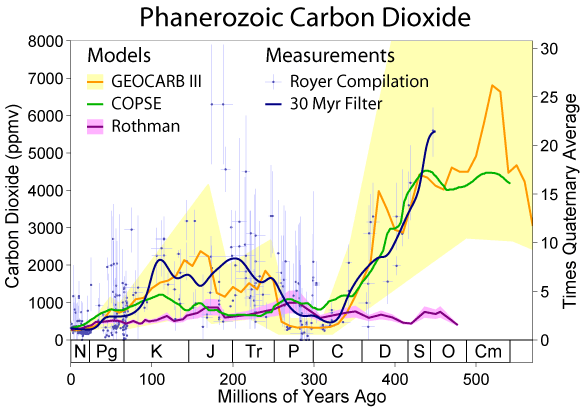File:Phanerozoic Carbon Dioxide.png
 |
This graph image could be recreated using vector graphics as an SVG file. This has several advantages; see Commons:Media for cleanup for more information. If an SVG form of this image is available, please upload it and afterwards replace this template with {{vector version available|new image name}}. |
Contents
Summary[edit]
This figures shows estimates of the changes in carbon dioxide concentrations during the Phanerozoic. Three estimates are based on geochemical modeling: GEOCARB III (Berner and Kothavala 2001), COPSE (Bergmann et al. 2004) and Rothman (2001). These are compared to the carbon dioxide measurement database of Royer et al. (2004) and a 30 Myr filtered average of those data. Error envelopes are shown when they were available. The right hand scale shows the ratio of these measurements to the estimated average for the last several million years (the Quaternary). Customary labels for the periods of geologic time appear at the bottom.
Direct determination of past carbon dioxide levels relies primarily on the interpretation of carbon isotopic ratios in fossilized soils (paleosols) or the shells of phytoplankton and through interpretation of stomatal density in fossil plants. Each of these is subject to substantial systematic uncertainty.
Estimates of carbon dioxide changes through geochemical modeling instead rely on quantifying the geological sources and sinks for carbon dioxide over long time scales particularly: volcanic inputs, erosion and carbonate deposition. As such, these models are largely independent of direct measurements of carbon dioxide.
Both measurements and models show considerable uncertainty and variation; however, all point to carbon dioxide levels in the past that have been signifcantly higher than they are at present. While the GEOCARB Carbon dioxide levels in the most part of the Phanerzoic Eon shows a fit and resultíng climate sensitivity similar to todays values, the early Phanerozoic includes a global ice age during the Ordovician age combined with high atmospheric carbon contents based on the same project. There have been different speculations about the reasons but no acknowledged mechanism so far.
Copyright[edit]
This figure was prepared by Robert A. Rohde from published data and is incorporated into the Global Warming Art project.
 |
Permission is granted to copy, distribute and/or modify this document under the terms of the GNU Free Documentation License, Version 1.2 or any later version published by the Free Software Foundation; with no Invariant Sections, no Front-Cover Texts, and no Back-Cover Texts. A copy of the license is included in the section entitled GNU Free Documentation License. |
| This file is licensed under the Creative Commons Attribution-Share Alike 3.0 Unported license. | ||
|
||
| This licensing tag was added to this file as part of the GFDL licensing update. |
References[edit]
- Bergman, Noam M., Timothy M. Lenton, and Andrew J. Watson (2004). "COPSE: A new model of biogeochemical cycling over Phanerozoic time". American Journal of Science 304: 397–437.
- Berner, RA and Z. Kothavala (2001). "GEOCARB III: A revised model of atmospheric CO2 over Phanerozoic time". American Journal of Science 301: 182-204.
- Gradstein, FM and JG Ogg (1996). "A Phanerozoic time scale". Episodes 19: 3-5.
- Gradstein, FM, JG Ogg and AG Smith () A geologic time scale 2004, Cambridge University Press ISBN 0521786738
- Rothman, Daniel H. (2001). "Atmospheric carbon dioxide levels for the last 500 million years". Proceedings of the National Academy of Sciences 99 (7): 4167-4171.
- Royer, Dana L., Robert A. Berner, Isabel P. Montañez, Neil J. Tabor, and David J. Beerling (2004). "CO2 as a primary driver of Phanerozoic climate". GSA Today 14 (3): 4-10. doi:10.1130/1052-5173(2004)014<4:CAAPDO>2.0.CO;2
- Veizer, J., Godderis, Y. & Francois. L.M., Evidence for decoupling of atmospheric CO2 and global climate during the Phanerozoic eon. Nature 408, 698-701 (2000) [1]
- Nir J. Shaviv, Ján Veizer: Celestial driver of Phanerozoic climate?, Geological Society of America Vol. 13, Issue 7 (Juliy 2003), S. 4–10, Online (pdf 454 KByte)[2]
Notes[edit]
- All data except GEOCARB III appear on the 2004 geologic time scale (Gradstein et al. 2005). GEOCARB III appears on the Gradstein & Ogg (1996) time scale.
- All models are reported in terms of the ratio of past CO2 concentrations to "present" CO2 concentrations, where "present" represents some average value for the last few million years. To compare to direct measurements a value of 260 ppmv is chosen for the recent period, with an uncertainty of 10-15%.
- No models are capable of resolving changes faster than ~10 Myr.
- Measurements based on the interpretation of paleosols sometimes result in apparent CO2 concentrations < 0 ppmv. These were set to 0 ppmv.
- Different measurements in the Royer et al. compilation come from different authors and involve different techniques. As such the error bars are not necessarily comparable. For example, some sources may have included only statistical measurement error, whereas others may have included statistical and systematic errors. Other measurements report no uncertainty at all. Because of these factors, the error measurements were ignored when determining the 30 Myr measurement average.
File history
Click on a date/time to view the file as it appeared at that time.
| Date/Time | Thumbnail | Dimensions | User | Comment | |
|---|---|---|---|---|---|
| current | 21:38, 25 February 2006 |  | 584 × 407 (31 KB) | Merikanto~commonswiki (talk | contribs) | Class Paleoklimatology, Phanerozoic Carbon Dioxide curve. |
- You cannot overwrite this file.
File usage on Commons
The following 4 pages link to this file:
File usage on other wikis
The following other wikis use this file:
- Usage on cs.wikipedia.org
- Usage on da.wikipedia.org
- Usage on de.wikipedia.org
- Usage on en.wikipedia.org
- Usage on eu.wikipedia.org
- Usage on fa.wikipedia.org
- Usage on he.wikipedia.org
- Usage on hr.wikipedia.org
- Usage on kn.wikipedia.org
- Usage on ko.wikipedia.org
- Usage on lt.wikipedia.org
- Usage on ru.wikipedia.org
- Usage on sh.wikipedia.org
- Usage on uk.wikipedia.org
- Usage on vi.wikipedia.org
